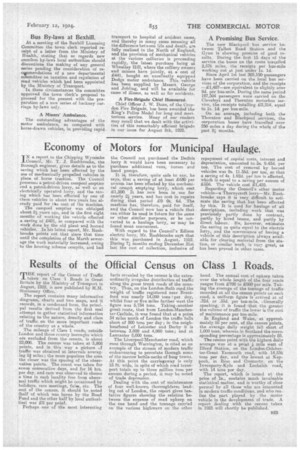Results of the Official Census on Class 1 Roads.
Page 9

If you've noticed an error in this article please click here to report it so we can fix it.
TBE report of the Census of Traffic taken on Class 1 Roads in Great
• Britain by the Ministry of Transport in August, 1922, is now published by H.M. Stationery Office. The report contains many informative diagrams, charts and two maps, and it records, in a condensed form, the principal results derived from the first real attempt to gather statistical information relating to the nature, density and class of traffic on the more important road's of the country as a whole.
The mileage of Class 1 roads, outside London and those county boronlis which are excluded from tho census, is about 22,000. The census was taken at 3,808 points, and in this way a picture uf traffic was obtained at intervals averaging 5i miles; the more populous the area the closer was the spacing of the observation points. The count was taken for seven consecutive days, and for 16 hrs. per day, and care was observed to choose a time in each locality free from abnormal traffic which might be occasioned by holidays, race meetings, faiire, etc. The cost of the census, it should be noted (half of which was borne by the Road Fund and the other half by local authorities) was £8 per point.
Perhaps one of the most interesting facts revealed by the census is the extraordinarily irregular distribution of traffic; along the great trunk roads of the country. Thus, on the London-Bath road the weight of traffic registered near Brentford was nearly 14,000 tons per day, whilst four or five miles farther west the figure was 5,734 tons. Taking :another great route, that from London-Manchester-Garlisle, it was found that at a point 34 miles north of London the traffic falls short of 500 tons per day; in the neigh. bouilood of Leicester and Derby it is between 3,000 and 4,090 tons; and at Lancaster 8,000 tons.
The Liverpool-Manchester road, which runs through Warrington, is cited as an example of the stream of modern traffic endeavouring to percolate through some of the narrow bottle-necks of busy towns. At this point the carriageway is only 15 ft. wide, in spite of which road transport totals up to three million tons per annum during a period, it may be noted. of trade depression. Dealing with the cost of maintenance of four well-known thoroughfares leading out of London, the report gives tentative figures showing the -relation between the expense of road upkeep on the one hand and the tonnage carried on the various highways on the other hand. The annual cost of upkeep taken over the whole length of the four roads ranges from £700 to £980 per mile. Taking the average of the tonnage of traffic recorded at all the census points on each road, a uniform figure is arrived at of .32d. or .33d. per ton-mile. Generally speaking, it is found that the greater the volume of traffic the lower is the cost of maintenance per ton-mile.
In England and Wales, at 'approximately 58 per cent, of the census points, the average daily weight fell short of 1,000 tons, whereas in Scotland the corresponding percentage is approximately 85.
The census point with the highest daily average was at a point * mile west of Ilford Station, on the Dondon-Colchester-Great Yarmouth road, with 14,536 tons per day, and the lowest at Keppooh, in Ross and Cromarty., on the Invergarry-Kyle and Lochalsh road, with 14 tons per day.
The report, -which is issued, at the price of is., contains much invaluable statistical matter, and is worthy of close perusal hy all those who are interested m modern traffic conditions, and who rea, lize the part played by the motor vehicle in the development of trade. A report dealing with the census .taken in 1923 will shortly he published.






























